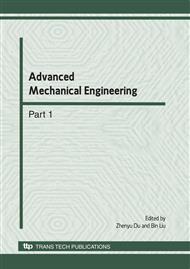[1]
Grant R.M. Toward a knowledge-based theory of the firm [J]. Strategic Management, 1996, 11(7): 109-122.
Google Scholar
[2]
Volberda H.W. Toward the flexible form: How to remain vital in hyper competitive environments[J]. Organization Science, 1996, 7(4): 359-374.
DOI: 10.1287/orsc.7.4.359
Google Scholar
[3]
Kee Young Kwahk, Hee Woong Kim, Hock Chuan Chan. A Knowledge Integration Approach for Organizational Decision Support[J]. Journal of Database Management, 2007, 18(2): 41-61.
DOI: 10.4018/jdm.2007040103
Google Scholar
[4]
Xiangyang Li , Charu Chandra. A knowledge integration framework for complex network management[J]. Industrial Management & Data Systems, 2007, 107(8): 1089-1109.
DOI: 10.1108/02635570710822769
Google Scholar
[5]
Cordon O, Herrera F., Lozano M. On the combination of fuzzy logic and evolutionary computation: a short review and bibliography[J]. Fuzzy evolutionary computation, 1997, 20(10): 33-56.
DOI: 10.1007/978-1-4615-6135-4_2
Google Scholar
[6]
Wang C. H, Tseng S. S, Hong, T. P. Design of a self-adaptive brain tumor diagnostic system[J]. Journal of Information Science and Engineering, 1995, 11(2): 275-294.
Google Scholar
[7]
W. H. Durham. Co-evolution: Genes, Culture, and Human Diversity[M]. Stanford University Press. (1994).
Google Scholar
[8]
A. C. Renfrew. Dynamic modeling in archaeology: What, when, and where? In Dynamical Modeling and the Study of Change in Archaelogy[M]. Edinburgh University Press. (1994).
Google Scholar
[9]
R. G. Reynolds. An introduction to cultural algorithms [C]. In Proceedings of the Third Annual Conference on Evolutionary Programming, World Scientific, River Edge, New Jersey, 1994: 131-139.
Google Scholar
[10]
Meng Fan-rong, Hao Xiao-yun, Zhou Yong. Selective Neural Network Ensemble Approach Based on Cultural Algorithm[J]. Journal of Chinese Computer Systems,2009, 30(5): 933-936.
Google Scholar
[11]
Zhang Di, Yang Yan, Tang Rui-Xue. New hybrid clustering algorithm based on cultural algorithms[J]. Computer Engineering and Applications. 2009, 45(4): 159-161.
Google Scholar


